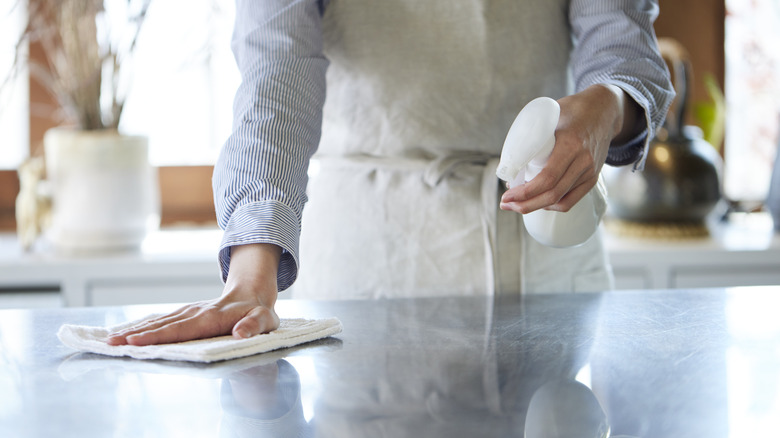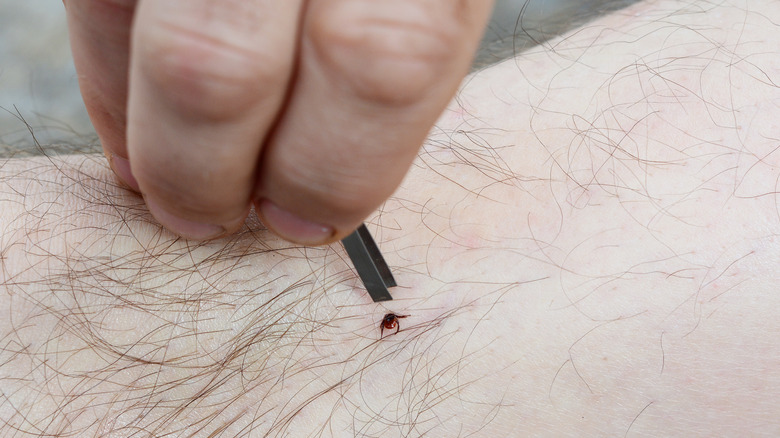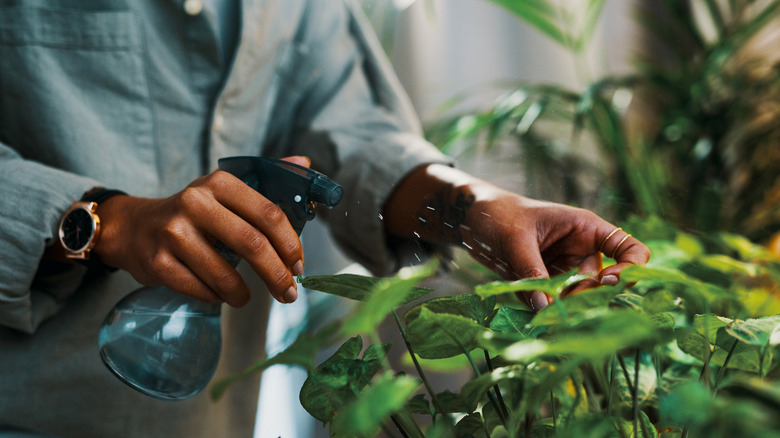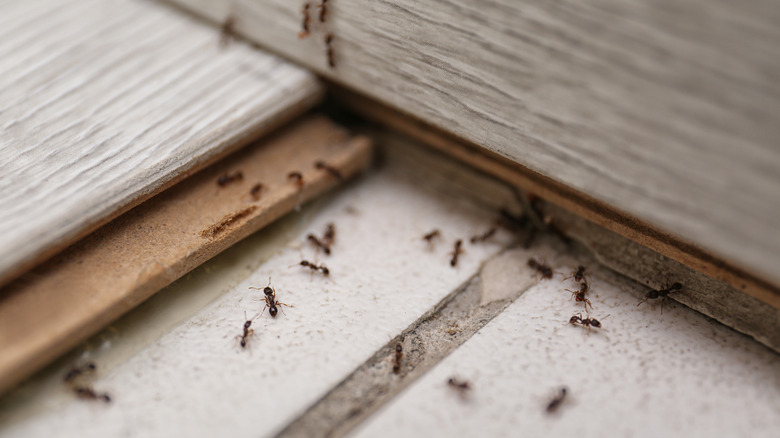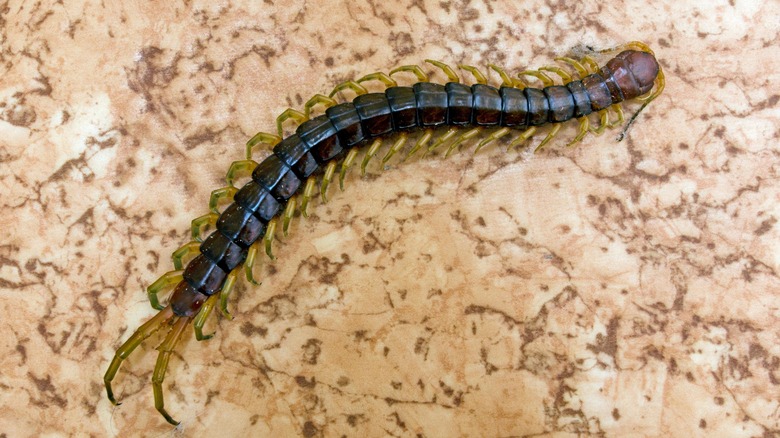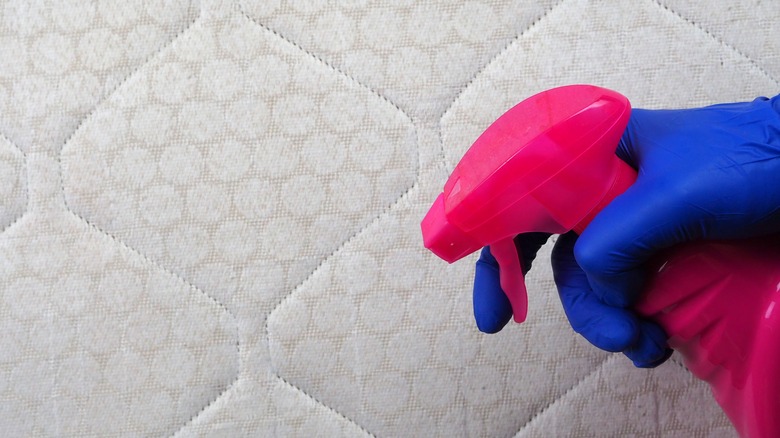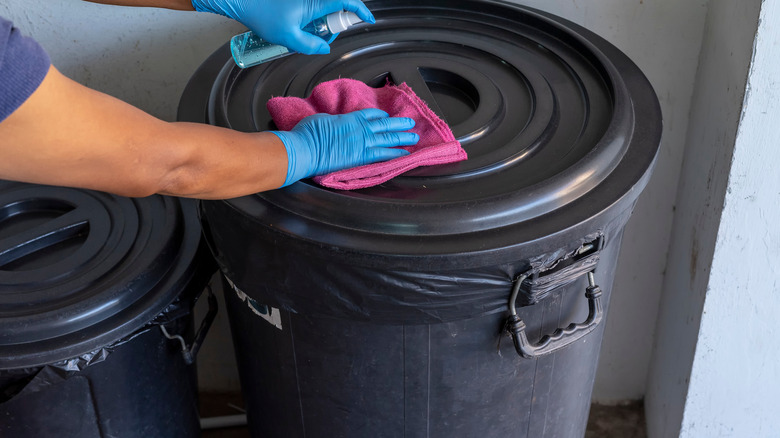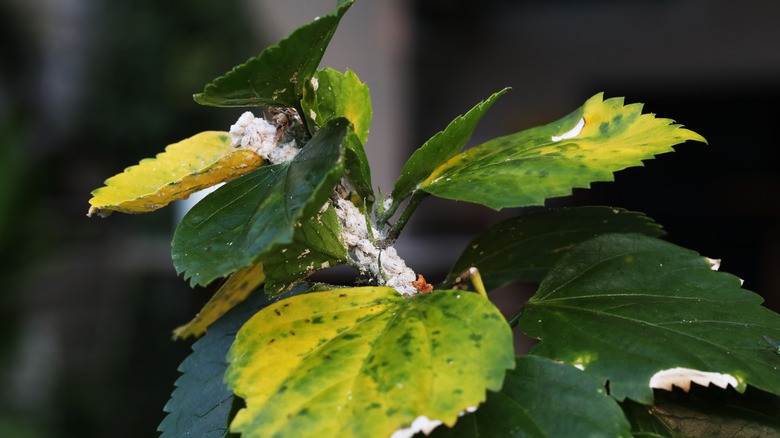Use Rubbing Alcohol To Remove These Pests From Your House
Rubbing alcohol has several uses around the home. It's a powerful germicide that can eliminate odors, and it works well for removing a slew of household pests. This miracle solution kills soft body pests by melting through their wax coating and causing them to dehydrate. Depending on your end goal, you can use this product on its own or in a mixture of water, soap, or vinegar.
If you plan on using isopropyl alcohol around the home, make sure you're doing so with safety in mind. When using rubbing alcohol on plants, stick with 50% isopropyl alcohol to keep leaf damage to a minimum. As for keeping yourself safe, make sure you have some form of ventilation when using rubbing alcohol indoors. It evaporates quickly and can be toxic when inhaled. Open windows in rooms that have them and use vent fans in bathrooms. It's also crucial not to use this flammable product around any hot surfaces, like a hot stove or heater.
Keep spider mites off your plant leaves
Spider mites are some of the most pesky creatures that houseplant lovers have to deal with. Luckily, you can remove them with an item you likely already have: rubbing alcohol. Not only does it work as a miticide, but it also makes it easier to wipe off several bugs at a time. The only downside to using this household chemical is its effect on leaves. Plants have a waxy layer on their leaves that gets stripped away with harsh products like rubbing alcohol. So, ensure you're only using a small amount at a time, and don't use rubbing alcohol more than twice a week. You may also need to dilute it with water when using on sensitive plants.
Quarantine any affected plants before you start removing pests to prevent spread. Pour some rubbing alcohol on a cotton ball, cotton pad, or cloth. Pull the leaf taut and gently wipe the soaked pad over the entire leaf, top and bottom, ensuring you don't miss any spots. Repeat this process on all infected leaves and stems, using fresh cotton balls if needed. Let the plant sit for a few hours and rinse thoroughly with water to remove any dead bugs and remaining liquid.
Remove ticks with rubbing alcohol
While there are various ways to remove ticks from your or your pet's body, you want to ensure you're doing so properly. Often, methods like scraping with a credit card or pinching and twisting run the risk of leaving the tick's head lodged underneath the skin. If you leave any part of this bloodsucker behind, you can infect the site. Not only does rubbing alcohol reduce the risk of bacteria entering the wound, but it also works well to kill ticks. You can also use alcohol to preserve their bodies – because these insects often carry diseases, having any biters sent off for testing is a good idea.
After a day of being in the great outdoors, it's crucial to search for ticks that may be attached to your body or clothes. Have a small jar or baggie with rubbing alcohol nearby. Use tweezers to gently latch onto the bug, being careful not to crush it, and submerge it in the liquid to kill it instantly. If one bites you, firmly grasp the tick's head as close to the skin as possible using fine-tipped angled tweezers. Gently but firmly pull the tick up and out, completely removing it. Clean the area near the bite with rubbing alcohol and wash your hands with soapy water. Place the body in the rubbing alcohol container to ensure it's dead and ready to go if you wish to test it. Although some claim rubbing alcohol can make a tick back out, most experts disagree. So, only use this product to drown and preserve ticks or disinfect the bite.
Kick aphids off your houseplants
You may have an aphid infestation if you've noticed damage to your garden foliage or houseplant leaves. Aphids are extremely tiny, only growing as big as ¼-inch in adulthood. Over 1,300 of the 5,000 species live in North America. These bugs can be black, white, gray, light green, yellow, or pink. Many garden plants and houseplants are targets for these little beasts, and they can quickly cause a lot of destruction. Signs of aphids include misshapen or yellow leaves, a sticky substance on your plants, and deformed fruits or flowers. Check the underside of the leaves, where they tend to hide. If you find these insects on your plant, you can use rubbing alcohol to prevent spread and possibly save your affected plants. Pure rubbing alcohol works by melting their waxy coating and kills them almost immediately on contact.
Use a rubbing alcohol solution with no additives to ensure it has what it takes to eliminate these pests. To make an aphid-destroying insecticide, mix equal parts water and 70% rubbing alcohol and add to a spray bottle. Some plants are sensitive to rubbing alcohol, so test a small spot and observe it for a few days. If there are no adverse reactions, spray the solution on infected areas. Avoid dousing the entire plant to prevent as much damage as possible.
Use rubbing alcohol to solve your ant problem
Ants are one of the most common household pests that can quickly take over your home. Although small, these little nuisances can cause a lot of frustration. If they get on your food, they leave harmful bacteria behind, which could lead to illnesses like streptococcus, E. coli, salmonella, and more. While most ants don't do household damage, carpenter ants create tunnels to form colonies, which can weaken your foundation. Luckily, ethanol works well as an ant spray to kill them on contact — rubbing alcohol dissolves their exoskeletons, causing them to dehydrate. It also works to repel ants by affecting their ability to smell. Ants use pheromone trails to signal to their families to follow them. Eliminate their scent pathways = eliminate ants.
To create your inexpensive, handy ant repellant, pour some rubbing alcohol in a spray bottle. While you can dilute it, full-strength 70% rubbing alcohol works best. Spritz any ants you see to kill them instantly. It's also a good idea to spray any areas where ants can easily squeeze in and therefore replace the dead colony. Focus on baseboards, windowsills, and doors. Continue this process weekly until you're confident you've resolved the ant problem. Another option to get rid of ants is to leave bowls of rubbing alcohol near any areas where you've noticed them pop up.
Get rid of centipedes
Even if you're brave when faced with most insects, centipedes are especially unsightly. Centipedes produce a toxic defensive spray to ward off predators, but it can also affect humans. If you get this secretion on you, it can cause burning pain that affects your skin and eyes. These nocturnal animals typically creep into homes during cold winter months in search of a warm, dark, and moist place to survive. If you want to kick them out of your house, rubbing alcohol can do the trick. As a bonus, you can spray them at a distance and avoid directly handling them until they perish.
Several forms of rubbing alcohol exist, but the best to tackle centipedes are options with higher concentrations, such as 98% pure alcohol. This will kill them more quickly than diluted formulas and is best for stray centipedes. If they're lurking in your plants, opt for a less-potent concentration to cause harm to the creature without damaging your houseplants. Use the direct stream option to shoot it, and fire as many times as needed to saturate it thoroughly. Carefully dispose of the pest in a bag once it's dead.
Nix bed bugs
Ridding your home of bed bugs is a frustrating task. These nocturnal pests are expert hiders and can become immune to pesticides. If you fail to eliminate them, they can leave itchy and irritating bites all over your body, making sleep difficult to enjoy. Rubbing alcohol can kill bed bugs and their eggs immediately after spraying by dissolving their protective shell and drying up their insides. However, it requires direct contact, so this method works best on early infestations.
You'll have a better chance to kill bedbugs with a higher concentration of alcohol, ideally 91% or above. Add rubbing alcohol to a spray bottle and cover these hiders' favorite spots. Switch the nozzle to the mist option and thoroughly coat furniture, dark areas they may be hiding in, and any clothing that may have come into contact with them. If you go with this approach and still have issues, you may need to call professional pest control.
Kill fruit fly eggs
Fruit flies seem to appear in your home overnight and reproduce rapidly. These flying inconveniences sneak in through trash, the garbage disposal, and drains. Although they only live a bit more than a month, they can lay up to a whopping 500 eggs. Luckily, the tiny offspring (and parents) are no match for rubbing alcohol. You can spray them directly to kill adult flies on contact or spray their eggs to eliminate them on the spot.
You can use straight rubbing alcohol or a mixture in a spray bottle. Adding a few drops of lemon essential oil will lure them, and dish soap will confine fruit flies in the bubbles. Use a paper towel to wipe up any dead fruit flies after blasting them with the solution. Because these pests lay eggs on rotten fruit, you'll also want to ensure they don't hatch. Spritz some rubbing alcohol in garbage cans containing expired food that may entice the little bugs.
Wipe out mealybugs
If you're having issues with the health of your houseplant, mealybugs may be the culprit. You'll know these creepy crawlers are to blame if you notice fluffy, white cotton-ball-like spots on the stems or leaves. They're sap suckers that steal the juices from your plant, causing it to turn yellow, look wilted, and eventually die. Mealybugs secrete honeydew, a sticky substance that can attract other pests, namely ants. Although they're resistant to insecticides, rubbing alcohol can seep through their wax coating and wipe them out.
To tackle mealybug outbreaks, start by dabbing a cotton pad in rubbing alcohol. You can typically find these cottony burdens hiding out in small leaf crevices and near the stem. Use your fingers to gently hold the leaf taut and wipe them off with your other hand. Because they're hiders, you'll want to thoroughly inspect your plant for any stray bugs. Once you've gotten all the mealybugs you can find, dispose of them in a small bag before throwing them away. Repeat this process in a week to take care of any offspring.
